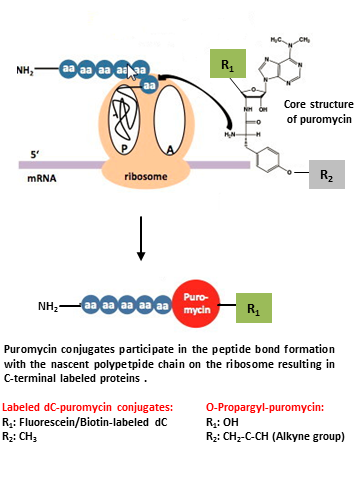The antibiotic puromycin is a structural analog of aminoacyl-tRNA that has been traditionally used as an inhibitor of protein synthesis since it specifically incorporates at the C-terminus of nascent polypeptide chains thereby stopping translation. Based on this observation, a new and significantly faster approach, using labeled puromycin conjugates, can be applied to both, specific C-terminal labeling of full-length protein in vitro[1,2,3,4] and non-radioactive monitoring of global protein synthesis in vivo[5,6,7].

Labeled dC-puromycin conjugates: Specific C-terminal protein labeling of full-length protein in vitro
C-terminal labeled full-length protein can be produced by in vitro translation in the presence of low concentrations of labeled dC-puromycin conjugates[1].
These proteins have been successfully used to analyze protein-protein interactions (pull-down assay, FCCS, protein-protein microarrays) and protein-DNA interactions (DNA microarrays)[2,3,4].
In contrast to traditionally applied posttranslational labeling approaches, additional time consuming purification steps can be avoided due to the synchronization of protein expression and labeling.
O-Propargyl-puromycin: Monitoring of global protein synthesis in vivo
Current studies of the cellular protein level rely on indirect methods such as DNA and mRNA microarrays or classical radioactive metabolic labeling with 35S-methionine.
O-Propargyl-puromycin is cell-permeable and readily incorporated into newly translated proteins thus providing a sensitive, nonradioactive method for direct monitoring of global protein synthesis[5].
The resulting C-terminal alkyne labeled proteins can be detected via Cu(I)-catalyzed click chemistry that offers the choice to introduce a Biotin group (Azides of Biotin → Click Chemistry) for subsequent purification tasks or a fluorescent group (Azides of fluorescent dyes → Click Chemistry) for subsequent microscopic imaging.
[1] Miyamoto-Sato et al. (2000) Specific bonding of puromycin to full-length protein at the C-terminus. Nucleic Acids Res. 28 (5):1176.
[2] Nemoto et al. (1999) Fluorescence labeling of the C-terminus of proteins with a puromycin analogue in cell-free translation systems. FEBS Letters 462:43.
[3] Doi et al. (2002) Novel Fluorescence Labeling and High-Throughput Assay Technologies for In Vitro Analysis of Protein Interactions. Genome Research 12:487.
[4] Kawahashi et al. (2007) High-throughput fluorescence labeling of full-length cDNA products based on a reconstituted translation system. J. Biochem. 141 (1):19.
[5] Liu et al. (2012) Imaging protein synthesis in cells and tissues with an alkyne analog of puromycin. Proc Natl Acad Sci USA. 109 (2):413.
[6] Stark et al. (2004) A General Approach to Detect Protein Expression In Vivo Using Fluorescent Puromycin Conjugates. Chemistry & Biology 11:999.
[7] Godman et al. (2011) Novel insights into the regulation of skeletal muscle protein synthesis as revealed by a new nonradioactive in vivo technique. The FASEB Journal 25:1028.